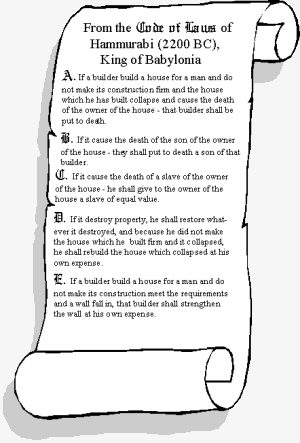Many of these disputes boil down to the difference between meeting local and/or national building codes (Figure 1 is the oldest known written building codes (translated) and dates back to 2200 BC) and good construction practice.
Although house builders know or at least should know the difference between building to code and building using good construction practices, most home buyers seem to believe that building codes force good construction practices on the house builder. This couldn’t be farther from the truth!
If you are considering buying a newly constructed house or having a house built to your specifications and the aforementioned statement shocks you. You are not alone!

Figure 1 - Oldest known building codes
Note: To add to the confusion, it is not always the contractor that is at fault. In many cases it is the architect who has decided to produce a set of building plans that follow the minimum allowable materials and construction techniques. The architect may have done this to provide more living space within budget constraints and/or he may just want to be a hero
and provide you, the homeowner, with a set of building plans that will allow for the construction of the least expensive house possible. Choosing a licensed architect can be as crucial as choosing a general contractor.
I will try to explain the differences between building codes and good construction practices.
Elected officials created building departments and those building departments created codes (it may be noted that there are national codes as well). The purpose of these codes is to ensure that any structure built is safe, under the most adverse of conditions, including earthquakes, hurricanes, heavy winds and overall environmental and meteorological impact for the people living in it, around it and using it.
The codes are a minimum set of safe construction rules and criteria. The key words in the previous sentence are minimum
and safe
. Notice the word comfort
is not part of the true criteria of building codes.
One of the most common disputes revolves around the word minimum
. Reputable house builders want to stay in business and to do so they must make a profit. Along with the construction of the house they will supply a warranty with their homes. With the warranty comes the potential of callbacks
for the house builder. A callback is when the homeowner has a problem and the house builder must send someone to fix it. The more callbacks, the more expense faced by the house builder. The more expense the less the profit.
Reputable house builders try to build houses from the outset that will not require any callbacks. In many cases this means that they must use construction practices that exceed those in the building codes.
As an example, if a house builder follows the minimum building code for the size and spacing of floor joists and then uses the minimum thickness and least expensive material for the sub-floor he will pass all the required building inspections. But that doesn’t mean that the floor won’t squeak!
Good construction practices will prevent the floor from squeaking!
Of course good building practice applies equally to home renovations, remodeling, improvements, additions and landscaping.
The statement, All our work is done to code
, is common amongst home improvement and remodeling companies. Although having any work done that just meets code, does not mean you will be pleased with the final project!
Avoid after the fact construction problems. Check out your builder or remodeler, before you sign on the dotted line.
Learn more about good construction practices for:
